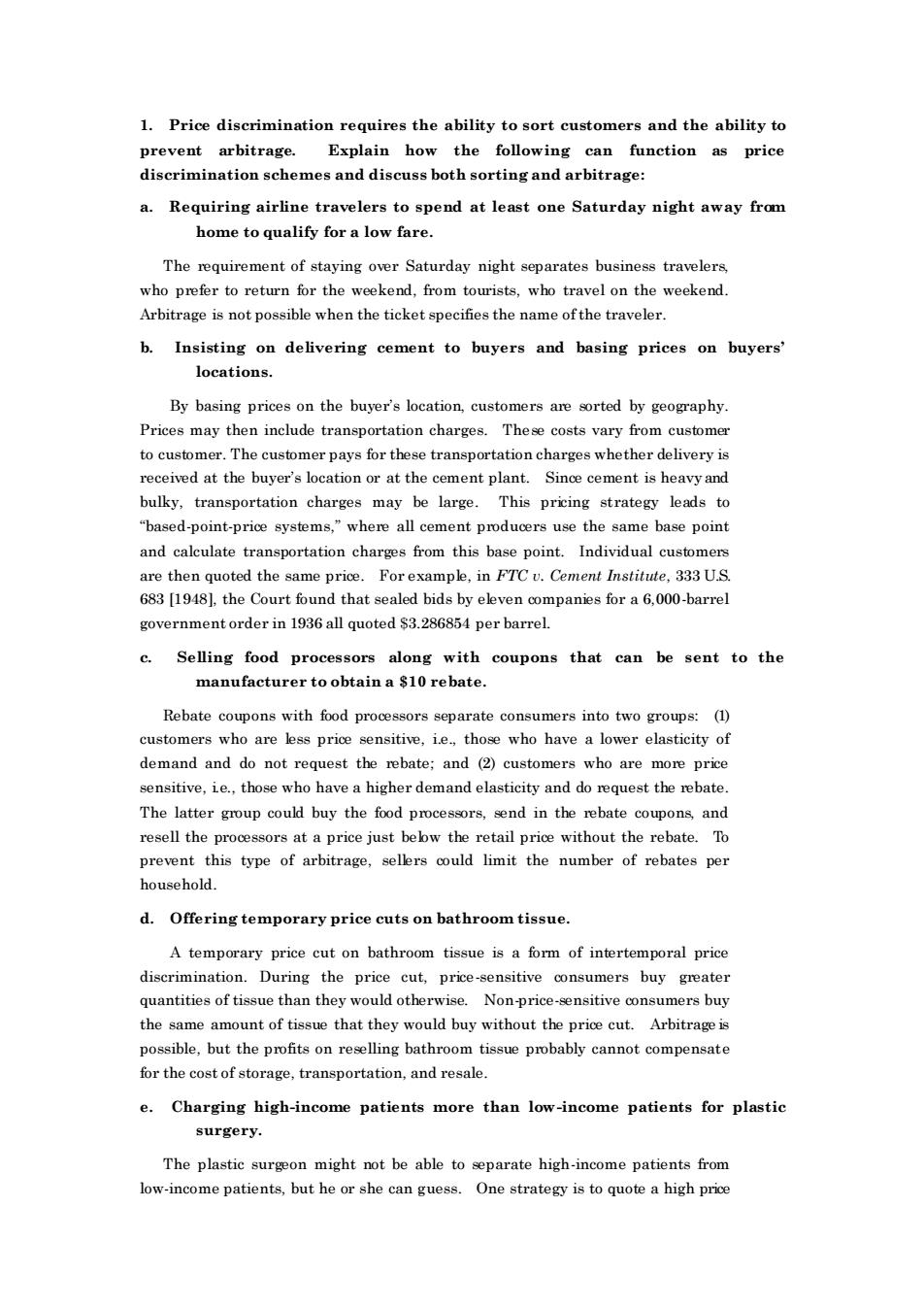正在加载图片...

1.Price discrimination requires the ability to sort customers and the ability to Explain how the following can function as price reeminagomes and diseus botorig a.Requiring airline travelers to spend at least one Saturday night away from home to qualify for a low fare. The requirement of staying over Saturday night separates business travelers who prefer to return for the weekend,from tourists,who travel on the weekend Arbitrage is not possible when the ticket specifies the name ofthe traveler. b.Insisting on delivering cement to buvers and basing prices on buvers' locations. By basing prices on the buyers location by geography Prices may then include transportation charges.These costs vary from customer to customer.The customer pays for these transportation charges whether delivery is received at the buyer's location or at the cement plant.Since cement is heavy and bulky.transportation charges may be large.This pricing strategy leads to "based-point-pri systems,"where all cment the same base point and calculate transportation charges from this base point.Individual custome are then quoted the same price.Forexample.in FTCv.Cement Institute,333 U.S 683 [19481.the Court found that sealed bids by eleven companies for a 6.000-barrel government order in 1936 all quoted $3.286854 per barrel. c.Selling food processors along with coupons that can be sent to the manufacturer to obtain a $10 rebate. s mers are ls demand and do not request the rebate:and (2)customers who are more price sensitive,ie.,those who have a higher demand elasticity and do request the rebate. The latter group could buy the food processors,send in the rebate coupons and 四” of arbitrage,selers could limit the numbe of re s per d.Offering temporary price cuts on bathroom tissue. A temporary price cut on bathroom tissue is a form of intertemporal price discrimination.During the price cut,price-sensitive consumers buy greater quantities of tissue than they would otherwise.Non-price-sensitive consumers buy the same amount of tissue that they would buy without the price cut.Arbitrage is possible,but the profits on reselling bathroom tissue probably cannot compensate for the cos of storage,transportation,and resale e.Charging high-income patients more than low-income patients for plastic surgery The plastic surgeon might not be able to separate high-income patients from low-income patients,but he or she can guess.One strategy is to quote a high price 1. Price discrimination requires the ability to sort customers and the ability to prevent arbitrage. Explain how the following can function as price discrimination schemes and discuss both sorting and arbitrage: a. Requiring airline travelers to spend at least one Saturday night away from home to qualify for a low fare. The requirement of staying over Saturday night separates business travelers, who prefer to return for the weekend, from tourists, who travel on the weekend. Arbitrage is not possible when the ticket specifies the name of the traveler. b. Insisting on delivering cement to buyers and basing prices on buyers’ locations. By basing prices on the buyer’s location, customers are sorted by geography. Prices may then include transportation charges. These costs vary from customer to customer. The customer pays for these transportation charges whether delivery is received at the buyer’s location or at the cement plant. Since cement is heavy and bulky, transportation charges may be large. This pricing strategy leads to “based-point-price systems,” where all cement producers use the same base point and calculate transportation charges from this base point. Individual customers are then quoted the same price. For example, in FTC v. Cement Institute, 333 U.S. 683 [1948], the Court found that sealed bids by eleven companies for a 6,000-barrel government order in 1936 all quoted $3.286854 per barrel. c. Selling food processors along with coupons that can be sent to the manufacturer to obtain a $10 rebate. Rebate coupons with food processors separate consumers into two groups: (1) customers who are less price sensitive, i.e., those who have a lower elasticity of demand and do not request the rebate; and (2) customers who are more price sensitive, i.e., those who have a higher demand elasticity and do request the rebate. The latter group could buy the food processors, send in the rebate coupons, and resell the processors at a price just below the retail price without the rebate. To prevent this type of arbitrage, sellers could limit the number of rebates per household. d. Offering temporary price cuts on bathroom tissue. A temporary price cut on bathroom tissue is a form of intertemporal price discrimination. During the price cut, price-sensitive consumers buy greater quantities of tissue than they would otherwise. Non-price-sensitive consumers buy the same amount of tissue that they would buy without the price cut. Arbitrage is possible, but the profits on reselling bathroom tissue probably cannot compensate for the cost of storage, transportation, and resale. e. Charging high-income patients more than low-income patients for plastic surgery. The plastic surgeon might not be able to separate high-income patients from low-income patients, but he or she can guess. One strategy is to quote a high price